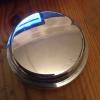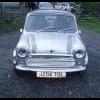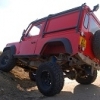
Exhaust Diameter
Started by
Slinky1313
, Oct 18 2010 10:07 PM
9 replies to this topic
#1

Posted 18 October 2010 - 10:07 PM
Hey all, I was just hoping to get some clear informed once and for all sort of answers when it comes to exhaust systems. My friend and I have not to long ago changed the standard 1.75 system for an LCB twin box straight through maniflow system with twinned side exits to go along with the 44 my friend and I installed. I THINK the system is a 2 inch diameter all the way through (cant remember for certain), but ever since installing the cars felt almost abit more sluggish. Seeing as adding the 44 isnt exactly the largest boost in power has the larger exhaust diameter genuinely effected the performance? or is it all just a load of bull after all? trying to find a straight infromed answer when it comes to this seems to be like finding a needle in a haystack. Really appreciate the help. Thanks all
Will
Will
#2

Posted 18 October 2010 - 10:18 PM
There's no doubt exhaust diameter makes a difference: too small and it's a restriction, too big and the gases lose the inertia that helps to drag the remaining fumes from the cylinder. I wouldn't like to say if that's your problem if you've also swapped the carb.
#3

Posted 19 October 2010 - 05:44 AM
Exactly, it may also just be down to tuning, however what size engine is it and in what state of tune... ie. is a full "race" engine, standard or somewhere in between ?
#4

Posted 19 October 2010 - 11:34 AM
its a 1275 metro engine, so far there has been no tuning really, I havnt even changed the needle from BFZ to BDL, I was reluctant to actually post this untill i had been able to tune it up a little bit but im at uni now so i figured i may aswell. So you think its more of just a tuning issue than the system i bought being to big for my setup? because the thing is i figured that with it being a 1275 and with the hif it would warrant the slightly larger pipe, but then it seemed to loose alot of bottom range tourqe and pep. Thanks very much for the replys
#5

Posted 19 October 2010 - 11:47 AM
I doubt you'd see that much of a noticeable difference on a standard engine, but it would undoubtedly show up on a dyno. I'd expect the smaller bore pipe to be a little bit better.
#6

Posted 19 October 2010 - 11:47 AM
the system will deffinitely effect the power but if you get the carb tuned right you shouldnt really notice much of a difference as you have changed the pipe the carb needs to be set up correctly again but ideally you would be running a 1.75" internal diameter all the way through 2" is just over kill really for that motor not that you will really notice that much with the carb jetted correctly and with the correct needle in
#7

Posted 19 October 2010 - 12:46 PM
The carb needle is going to be your biggest issue. What air filter are you using? If you are using a K&N or similar on an MG Metro engine, try a BBW to start with. If it's an Austin Metro engine, try a BDL. Either way, the only sure way of getting it spot on is on a rolling road.
As already suggested, a 2" exhaust system is a bit large for an otherwise standard 1275. 1.75" systems like the RC40 seem to work best right up to 100bhp or so.
As already suggested, a 2" exhaust system is a bit large for an otherwise standard 1275. 1.75" systems like the RC40 seem to work best right up to 100bhp or so.
#8

Posted 19 October 2010 - 09:12 PM
yeah im using a k&n filter, the BDL is what i was gonna pick up. i cant really rolling road it for 2 reasons, the guy i knew who had them and knew minis sold them, and its like 100 pound lol. I was abit worried that it was gonna be best as a 1.75. o well, any performance upgrades you could recommend to bring it up to snuff lol. also just to divert a little bit does anyone know if i need to change the jet and spring aswell as the needle or will it be fine as it is? thanks very much.
Will
Will
#9

Posted 19 October 2010 - 10:34 PM
All Hif44's use a 0.1" jet, or they should. It's unlikely you'll need to alter the spring, you could rig up a tell tale on the carb piston to show if & when it reaches maximum travel. A loosely gripping band on the damper tube or a coating of soot or grease that will be wiped by the piston as it rises.
#10

Posted 20 October 2010 - 09:40 AM
If the exhaust pipe has been measured at 2" outside diameter, then that makes it 1.875" internal, which is not too bad. If you are intending to regularly use a 1275 at over 6000 rpm and want the power at the top end, then the 1.875" internal is fine. The 1.75" internal which is usually regarded as optimum is great for 1275's using up to about 6500 with peak power at from 3000 rpm to 6500 rpm. For a racing Mini using, say, over 8000 rpm, then even a 2.25" int dia pipe would be good.
It's just that, as a general guide, a 1.75" ID will always give a good result for road or rally engines. What really seems to sap the power is going from, say, a 1.75" main pipe to an oversize final exit pipe - obvious really, as the final pi;pe is only passing the same overall volume of exhaust gas as the main pipe. As said above, the optimum velocity of the exhaust gas is what is important.
It's just that, as a general guide, a 1.75" ID will always give a good result for road or rally engines. What really seems to sap the power is going from, say, a 1.75" main pipe to an oversize final exit pipe - obvious really, as the final pi;pe is only passing the same overall volume of exhaust gas as the main pipe. As said above, the optimum velocity of the exhaust gas is what is important.
1 user(s) are reading this topic
0 members, 1 guests, 0 anonymous users

















